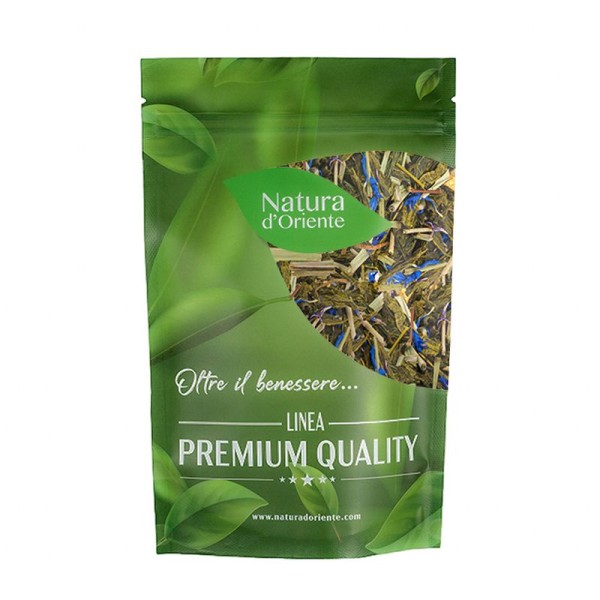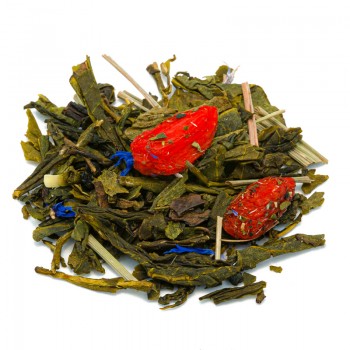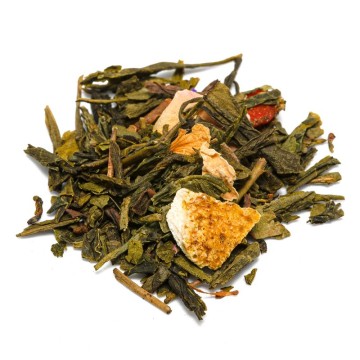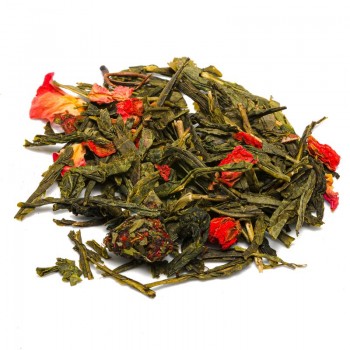An intense blend of green tea, ginseng, ginger with notes of cornflower and lemongrass. A fresh, energizing drink, which promises a balanced taste between spicy and sweetish notes, with a sweet aroma and a soft finish. It is an excellent tea for the morning, which gives strength and vitality thanks to its ingredients, all known for the benefits they bring to our body.
Ginseng and Ginger green tea: properties and benefits
Green tea with ginseng and ginger provides useful properties to soothe the symptoms of colds and throat irritation, and simultaneously strengthen the immune system. It helps as a tonic to reduce the effects of fatigue and stress, since ginseng helps increase energy and resistance. Ginseng is a root with adaptogenic effects, because it supports the body to adapt to the stress and conditions in which it finds itself. It favors the regulation of hormone levels and stimulates the metabolism for the correct absorption of lipids. It can support the regulation of cholesterol and triglycerides, promoting the well-being of the cardiovascular system.
Ginger can promote proper digestion and intestinal transit, and has been known for centuries as a treatment for nausea . Its action prevents irritation and excessive inflammation of the body during meals. Some components of ginger, such as shogaols and gingerols, have a gastroprotective and antioxidant activity; they help to stimulate the correct metabolism of sugars to counteract excessive blood sugar. Ginger can also help relieve menstrual cramps and muscle aches. It is a food rich in vitamins and minerals, which add up to those of green tea. When combined together, ginseng and ginger are prized for their antioxidant benefits. The base of Sencha green tea simplifies the assimilation of polyphenols and beneficial substances even more. Polyphenols are plant-based antioxidants that help reduce the damage to our cells caused by unstable oxygen molecules; they have an excellent anti-aging function and protection against oxidation attacks due to smog, poor diet, excess of drugs, and other factors.
Origins and History of cultivation
The green tea used in the blend is Sencha, a term that refers to specific green teas, processed with a steam cooking method. Sencha is a food that has been a part of Japanese culture for centuries. Tea was introduced from China, precisely by Japanese Tibetan monks who brought the plants home after a study trip. Since then, around the eighth century, there were various customs related to tea, until in 1738 Nagatani Souen (a tea farmer) perfected the method of making Sencha. It is steamed to stop the leaves from oxidizing, then cooled and rolled. Its "needle-like" appearance makes it recognizable.
Today it is the favorite tea of the Japanese, often grown in full light or in some cases with shaded leaves before harvesting. It is a tea rich in theanine, which is transformed into catechins causing a bitter and astringent taste, and the shading serves to prevent this process. The pickers in the fields pick the tea leaves at specific times of the year, and it is precisely these times that determine the taste of a Sencha tea. The most valuable and expensive is spring tea. The history of the ginseng root is very ancient, the Panax ginseng plant having been known for thousands of years.
It was discovered about 5000 years ago in the territory of Manchuria, China. It is native to the mountainous regions of the Far East, between Russia, China and Korea. Ginseng is now also grown in some areas of Japan, with the variety of Panax japonicus. There are actually many different species of ginseng, spread all over the world. In addition to Panax ginseng, also called Korean ginseng or referred to as Panax ginseng C.A. Meyer (named after a Russian scientist), there is also Panax quinquefolius - the American ginseng found in Canada and the United States. The root, used as food, was successful thanks to its properties, especially in China. It was a precious root and used by emperors, already before the Han dynasty (about 200 BC). It was revered because it brought vigor, health, virility and long life. In some periods, its use was forbidden to all but the imperial family. The term Panax comes from the Greek word panakeia, which means panacea or “universal remedy” that heals all evil, practically.
This derives from the qualities attributed to ginseng by Chinese medicine, which used the dried root as a tonic to replenish vital energy, and as a treatment for anemia, insomnia, gastritis, blood pressure abnormal and general fatigue. Medical texts described ginseng in almost magical terms, able to calm the mind, bring harmony to the soul, eliminate fears and evil spirits. Obviously it represented an elixir of life. A curiosity: ginseng has a historical role as an aphrodisiac, still highly appreciated today. Over time, the Chinese demand for ginseng increased a lot, spreading to all sections of the population, and a notable trade was created, especially from Korea. In the twentieth century, the demand for ginseng exceeded the availability of wild ginseng and Korea began its cultivation, which continues to this day.
Ginger is another food that comes from the Orient, known for over 4000 years. In fact, in 500 BC, the Chinese philosopher Confucius presented ginger as indispensable at the table, to aid digestion. In the West it has been widely used in medicine for over 2000 years. Today it is one of the most cultivated plants in the world, and the part used is its root. It was first exported from India and used extensively by the Romans, became rare after the fall of the Roman Empire, and the Arabs reintroduced it via their spice trade from the Orient. Ginger was expensive in the Middle Ages, but after Marco Polo's journey it returned to circulation among European herbalists. It was used for its warming and healing effects, welcome in the cold climate of Northern Europe. In recent centuries ginger tea and biscuits were often served to guests to settle the stomach and aid digestion.
Plant and flowers
Tea comes from the leaves of the evergreen plant Camellia Sinensis (also called Thea sinensis) belonging to the Theaceae family. It is a plant native to East Asia, the genus of which includes about 250 species. Those used to produce tea are usually 3: sinensis, assamica and Cambodian. The plant is grown in small dimensions, although it can reach 9 meters. The small shrubs make it easier to harvest the foliage by hand; for this they are pruned often, stimulating the growth of new tea leaves and shoots. The flowers are fragrant, yellow or whitish, and the fruit bears only one seed. Ginseng root comes from Panax ginseng, a perennial plant also known as Chinese or Korean ginseng. It grows slowly in the mountains of eastern Asia, and is one of the longest-lived plants: the roots are harvested 5-6 years after planting. The tuberous root, resembling a human shape, has a yellowish-gray color and a fleshy texture. Nutritional values of green tea with ginseng and ginger On a nutritional level, green tea contains various antioxidant polyphenols, including catechins and EGCG (Epigallocatechin gallate). It makes methylxanthines (caffeine, theobromine, theophylline), vitamin C and group B vitamins (thiamine, riboflavin, niacin) available to our body. Ginseng root contains substances such as vitamins B, C, phosphorus, essential oils and germanium. Furthermore, it includes compounds with immunomodulatory activity that stimulate the production of antibodies and cytokines. Ginger is rich in vitamins A, B, C, E. It also contains minerals such as potassium, calcium, magnesium, iron, zinc and phosphorus. Contains particular substances, gingerols and shogaols, studied for their potential benefits on the body. How to prepare green tea with ginseng and ginger Green tea with ginseng and ginger is obtained by placing about 3-5 grams of the mixture with water at 80°C in a cup (250 ml). Let it steep for 2 to 3 minutes before drinking this green tea. Add honey or sugar, if desired.
Nutritional values of Ginseng and Ginger green tea
This green tea can also be harmful to some people, if taken in large doses. Side effects include insomnia, headache, heartburn, dizziness, diarrhea, anxiety and nervousness. In some cases, also irregular heartbeat, changes in low and high blood pressure. Excessive doses of this green tea, ginseng and ginger can cause high blood pressure, hence people suffering from a particular heart condition. The same is recommended for those suffering from chronic diseases of the thyroid, metabolism, liver and kidneys. Ginseng, in large quantities, should not be taken together with alcohol, caffeine, drugs such as antidepressants and blood thinners. The amount of ginseng contained in tea is rather low, and can be considered sTake care if you do not exceed the doses. Caution is advised for any known allergies in the ingredients of the infusion, and for pregnant and breastfeeding women.

![Ginseng and ginger green tea [Natura d'Oriente] Ginseng and ginger green tea [Natura d'Oriente]](https://www.naturadoriente.com/3367-large_default/Green-tea-ginseng-ginger.jpg)



![Ginseng and ginger green tea [Natura d'Oriente] Ginseng and ginger green tea [Natura d'Oriente]](https://www.naturadoriente.com/3367-home_default/Green-tea-ginseng-ginger.jpg)



 No reward points for this product.
No reward points for this product.





![Green tea with orange and grapefruit [Natura d'Oriente]](https://www.naturadoriente.com/3376-home_default/green-tea-with-orange-and-grapefruit.jpg)





![Green Tea Ceylon Melfort Special [Natura d'Oriente]](https://www.naturadoriente.com/3378-home_default/-green-tea-ceylon-melfort-special-.jpg)



